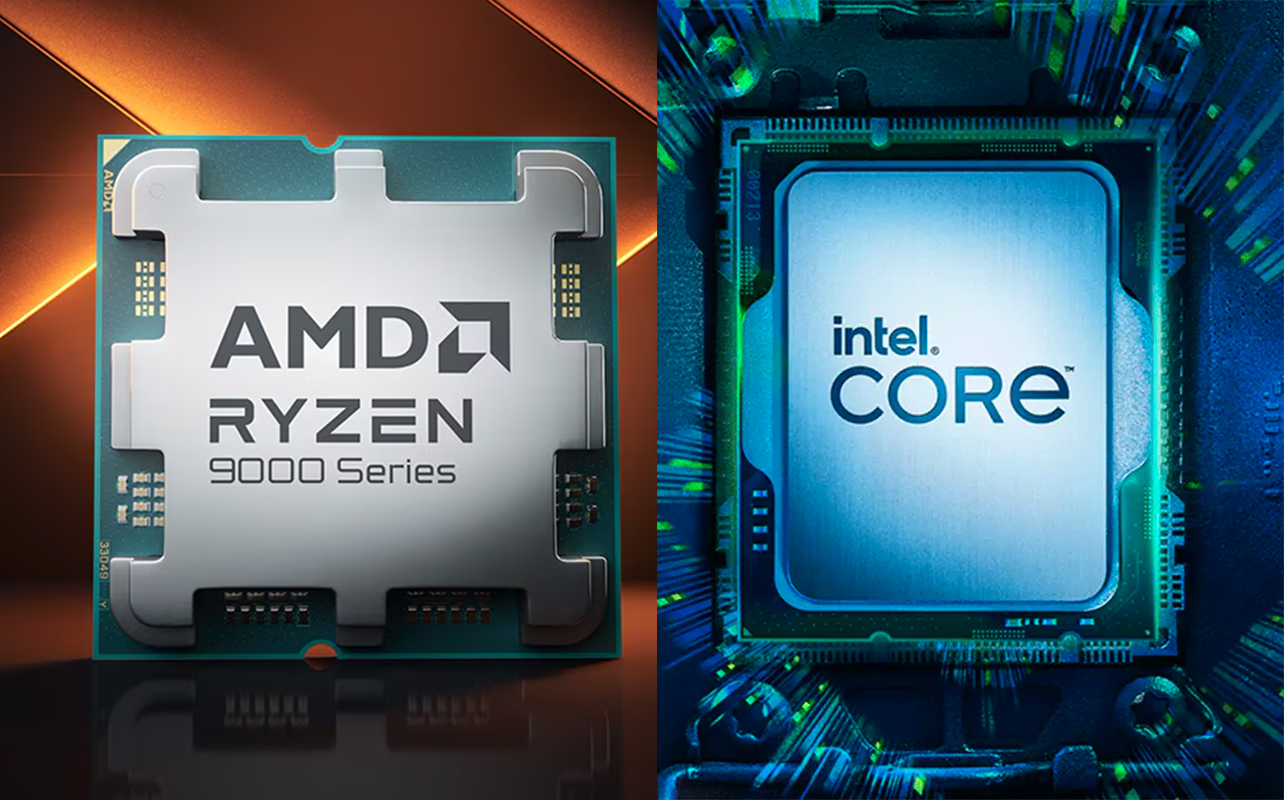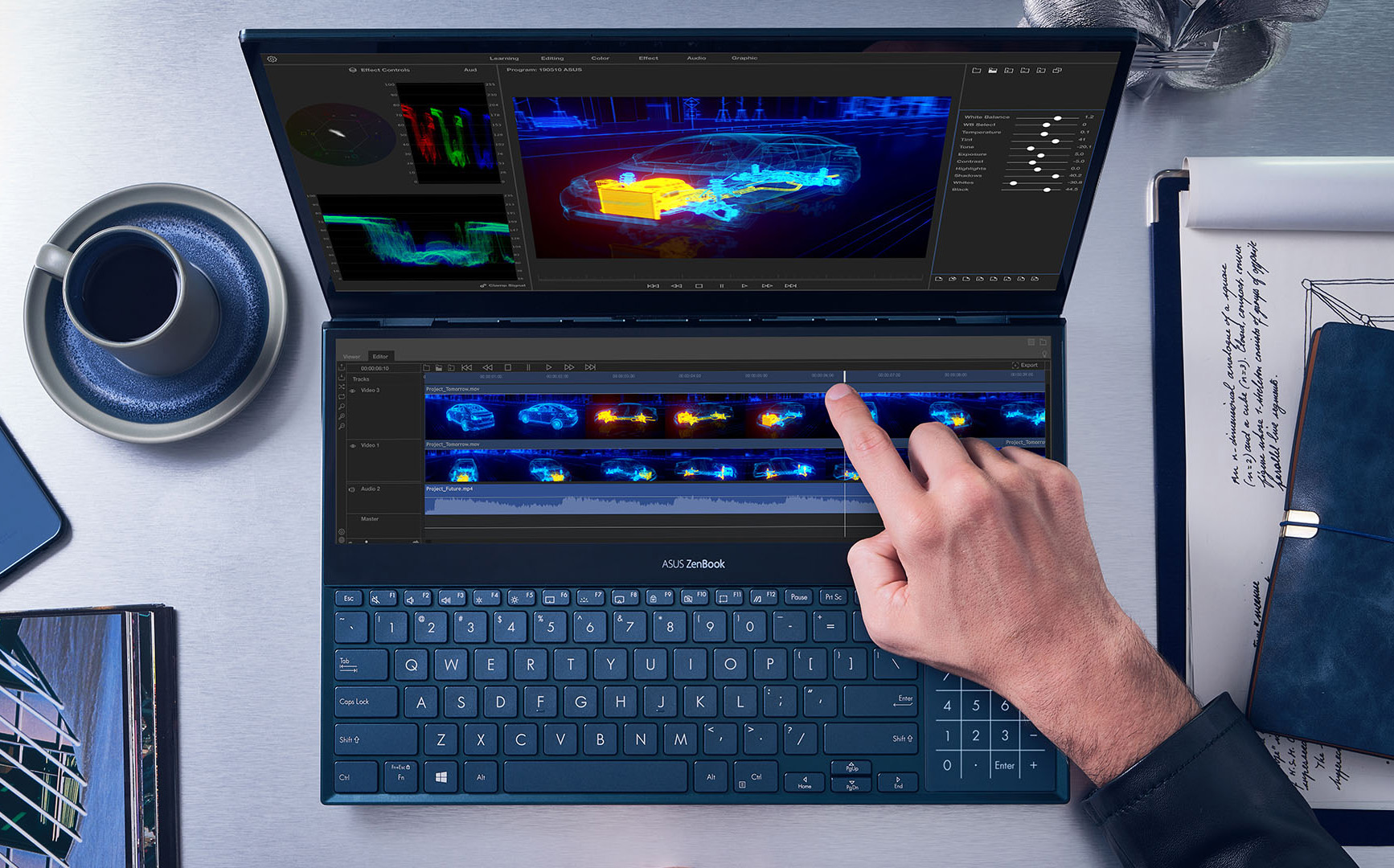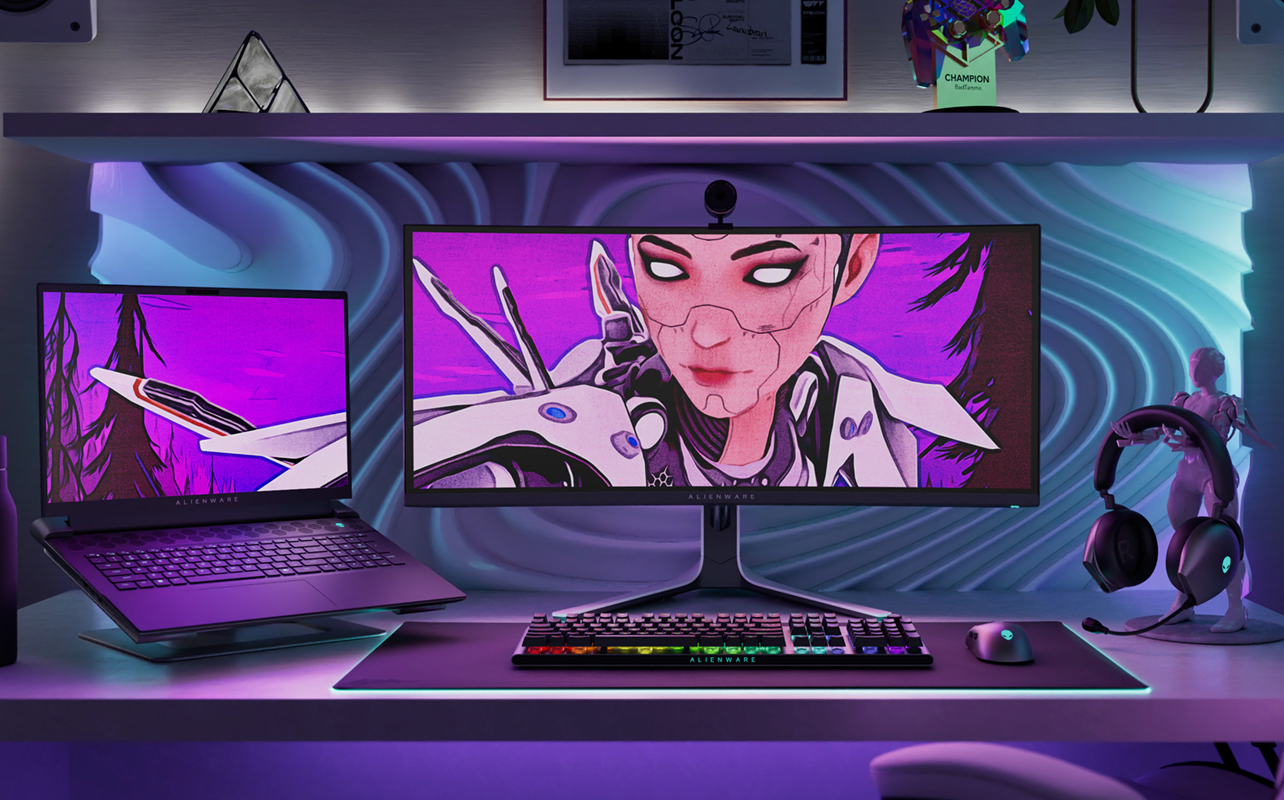
Building or upgrading your computer? Choosing between AMD vs Intel can feel overwhelming—both brands offer high-performance CPUs. The computer processor is essentially your system’s brain, and they come in different levels of power and performance. That’s why going with an AMD or Intel processor can impact everything from gaming frame rates to what kind of upgrades you can make down the line. Weighing their respective advantages can help you shop for a new computer or build a custom PC.
This guide will walk you through the key differences between AMD and Intel CPUs, compare performance and efficiency, and explore real-world use cases to help you confidently pick the right processor you need.
What is the difference between AMD and Intel CPUs?
At a high level, AMD and Intel take slightly different approaches to CPU design. AMD’s Ryzen lineup leans heavily into multi-core performance and power efficiency, while Intel focuses on delivering high clock speeds and excellent single-core performance.
Difference in Architecture
AMD uses its “Zen” architecture (now in its 4th generation, Zen 4), which is built on a smaller 5nm or 6nm manufacturing process depending on the chip. Intel, meanwhile, uses Intel 7 process node since the 12th Gen, which is roughly equivalent in scale to a 10nm process. These differences in architecture result in varying thermal behavior, power efficiency, and core design strategies between the two brands.
AMD processors also tend to offer more cores and threads at each price point. That makes Ryzen chips appealing to users who run multiple demanding applications or do a lot of content creation. Intel chips, on the other hand, often win out in pure single-threaded performance, which can make them more appealing to gamers and general users.
Platform and chipset compatibility
The motherboard ecosystem is an important consideration. AMD has offered long-term support for its AM4 and now AM5 sockets, meaning you can often upgrade your chip without replacing your entire motherboard. Intel tends to change sockets more frequently (such as LGA1200, LGA1700), which might require more components to be upgraded together.
From a platform perspective, AMD typically offers more upgrade flexibility. Its recent AM5 socket, for example, is expected to support multiple future CPU generations, allowing users to upgrade their processor without changing the motherboard. Intel platforms tend to remain consistent within a single generation, but socket changes are more frequent between generations. For instance, Intel’s LGA1700 socket supports both 12th, 13th, and 14th Gen CPUs, but upcoming generations like Arrow Lake will require a new socket (LGA1851). Meanwhile, AMD’s Ryzen 7000 and 9000 series both use the AM5 socket, while older Ryzen 5000 chips use the AM4 platform.
Learn about what to look for when shopping for a new laptop based on specifications.
AMD vs Intel CPUs: side-by-side comparison
Here’s a closer look at how AMD’s Ryzen 7000 series and up stack up against Intel’s 13th and 14th Gen CPUs across key technical specs.
| Feature | AMD Ryzen 7000 and up | Intel 13th and 14th Gen |
|---|---|---|
| Architecture | Zen 4 / Zen 5 (AM5 socket) | Raptor Lake / Raptor Lake Refresh (LGA 1700) |
| Manufacturing Process | 5nm (TSMC for Zen 4/5) | Intel 7 (10nm Enhanced SuperFin) |
| Platform Longevity | AM5 socket expected to be supported through 2027+ | LGA 1700 ends with 14th Gen (no support for Arrow Lake) |
| Overclocking Support | Supported on all unlocked models | Supported on K/KF models + Z-series boards |
| Chipset/Motherboard Cost | Mid-range boards (B650) are affordable | Entry boards (B660/B760) are affordable |
| PCIe Support | PCIe 5.0 for GPU and SSD | PCIe 5.0 for GPU, limited SSD support |
| DDR5 Support | DDR5 only (on AM5) | DDR4 or DDR5 (board dependent) |
Key considerations when choosing the right processor for you
It’s important to look beyond the brand and consider how AMD and Intel processors perform in gaming, creative tasks, energy use, and long-term upgrades.
Gaming performance
Both brands bring a lot to the table—but with some key differences. Intel CPUs are often the go-to for gamers looking to squeeze every frame per second out of their system. The reason? Their high clock speeds and strong single-core performance give them the edge in many gaming benchmarks, especially for fast-paced competitive titles. High clock speeds mean a processor can execute more cycles per second, which directly boosts game performance in titles that rely on quick, real-time responsiveness. Strong single-core performance is especially important in games that don’t take advantage of multiple cores.
That said, AMD Ryzen chips, especially the 7000-series and above, are no slouches. They’re excellent for gaming when paired with a powerful graphics card and offer great multitasking if you’re streaming or running other apps while you play. You just don’t get the same overclocking capability in case you want to push your PC further to play games at higher settings.
Graphics support
Graphics capability is just as important for creators as it is for gamers—especially if your work involves video editing, animation, or 3D rendering. Intel’s integrated graphics (available in most i3, i5, and i7 CPUs) are convenient for basic visual tasks or lightweight creative workflows. Integrated graphics are built into the CPU and handle visuals without needing a separate graphics card. However, professional creators will want a dedicated GPU regardless of brand to take the load off the CPU.
AMD’s Ryzen G-series chips come with integrated Radeon graphics, which can handle entry-level creative tasks, but for serious content creation, pairing either CPU with a dedicated graphics card like an AMD Radeon or NVIDIA RTX GPU is the way to go. A strong CPU-GPU combo ensures smoother playback, faster rendering times, and better support for high-res content.
Productivity and multitasking
If you’re the type who always has multiple tabs, editing software, and virtual machines running, AMD Ryzen chips generally come out ahead. With more cores (individual processors within the CPU) and threads (the virtual versions of cores that help manage multiple tasks), AMD excels at productivity tasks like video editing, 3D rendering, and code compiling. Allocating resources this way reduces CPU load, which in turn helps preserve battery life.
Intel has stepped up in recent years with its hybrid core architecture—performance cores for heavy lifting and efficiency cores for background tasks. This has helped Intel close the gap in multitasking and creative workflows.

Thermal efficiency and power draw
AMD typically has the edge when it comes to thermal performance and power efficiency. Thanks to its smaller process nodes and chiplet architecture, AMD CPUs tend to run cooler and consume less power under load. Intel’s recent chips offer top-tier performance but often at the cost of higher power draw and more heat. This means you may need beefier cooling solutions, especially with high-end Intel CPUs like the Core i9 series.
Compatibility and future upgrades
Want to build a PC that’s future-proof? AMD might be the safer bet. The AM5 socket (used by Ryzen 7000 series) is expected to support several future generations of CPUs, meaning you can upgrade your chip without changing your motherboard. Intel changes sockets more often. For example, the LGA1700 socket introduced in the 12th Gen CPUs may not support newer generations beyond a certain point, though the 13th and 14th Gens both use the same socket thus far. This makes a difference if you want to upgrade components over time rather than replace your whole system.
Pros and cons of AMD and Intel CPUs
Here’s a quick look at AMD vs. Intel in how they shine—and where they fall short:
AMD CPUs
Pros:
- Excellent multi-core performance, which is ideal for creative workloads like editing, rendering, and compiling.
- More energy-efficient, meaning they run cooler and consume less electricity.
- Long-term socket support (AM4, AM5) gives you flexibility to upgrade without changing motherboards.
Cons:
- Most models require a dedicated graphics card, which adds to the total build cost.
- Some chipset fragmentation (AM4 vs AM5) can be confusing when planning upgrades.
Intel CPUs
Pros:
- Strong single-core and gaming performance, making them a top choice for competitive gamers.
- Integrated graphics in most models, perfect for simpler builds or users without a dedicated GPU.
- Great platform stability during each generation, making it easier to plan a complete build.
Cons:
- Higher power consumption can lead to more heat and demand better cooling solutions.
- More frequent socket changes mean you may need a new motherboard for future CPU upgrades.
Choosing the right CPU for your computing needs
Whether you’re gaming, creating content, handling office work, or planning a future upgrade, some CPU features will matter more to you than others.

Gaming
If you’re building a rig focused on gaming, you’ll want fast core speeds, large caches, and solid GPU compatibility. A high cache allows the processor to store frequently used data for quicker access, which can improve game loading times and responsiveness.
Intel has long been a favourite for competitive gamers due to its high frame rate performance in titles that benefit from strong single-threaded speeds. That said, AMD is a great choice for gamers who also stream or run background apps. A Ryzen 7 or 9 CPU paired with a good GPU delivers a smooth experience across the board.
Content creation and streaming
For tasks like video editing, 3D animation, or audio production, the number of cores and threads becomes crucial. More of them means your computer can handle multiple heavy tasks at once without slowing down. AMD’s Ryzen 9 and Threadripper lines shine here, handling complex workloads with ease. Intel’s newer hybrid architecture brings it close in terms of overall performance, especially with i7 and i9 models. But AMD still has the edge in raw core counts at similar price points.
Everyday and office tasks
For browsing, emails, Zoom calls, or basic document editing, both brands do the job well. Intel’s integrated graphics give it a slight edge for plug-and-play setups with no dedicated GPU. Tasks like these don’t necessarily need the additional power of dedicated graphics since integrated graphics can handle them well on their own. AMD’s Ryzen 5 and G-series CPUs are also solid choices here—just ensure you’re picking one with onboard graphics if you’re not using a graphics card.
Building a future-proof PC
When it comes to long-term planning, AMD currently offers more certainty. The AM5 socket is designed for several future generations, and AMD has committed to extended support. This means you can upgrade your CPU later without replacing your motherboard. Intel’s approach usually involves more frequent platform changes, which can add extra cost and complexity when you want to upgrade your CPU later.
Find the best processor for your performance goals
Which processor is better for your needs? That depends a lot on your CPU requirements, your budget, and your long-term plans. If you’re looking for top-tier gaming performance with high frame rates, Intel holds an advantage. For productivity and multitasking, AMD often takes the lead, thanks to its higher core and thread counts. AMD also pulls ahead when it comes to energy efficiency and future upgrade flexibility. On the other hand, Intel’s CPUs tend to offer strong out-of-the-box performance with integrated graphics, making them great for simple builds. Ultimately, you can’t go wrong with either—it’s about finding the processor that fits how you use your computer day to day. These recommendations are based on balancing performance, value, and upgrade options for users.
Ready to choose your next CPU? Browse Best Buy’s wide selection of AMD and Intel CPUs to find the perfect processor for your build.
This article was drafted using AI technology and then reviewed, fact-checked, and revised by a member of our editorial team.





